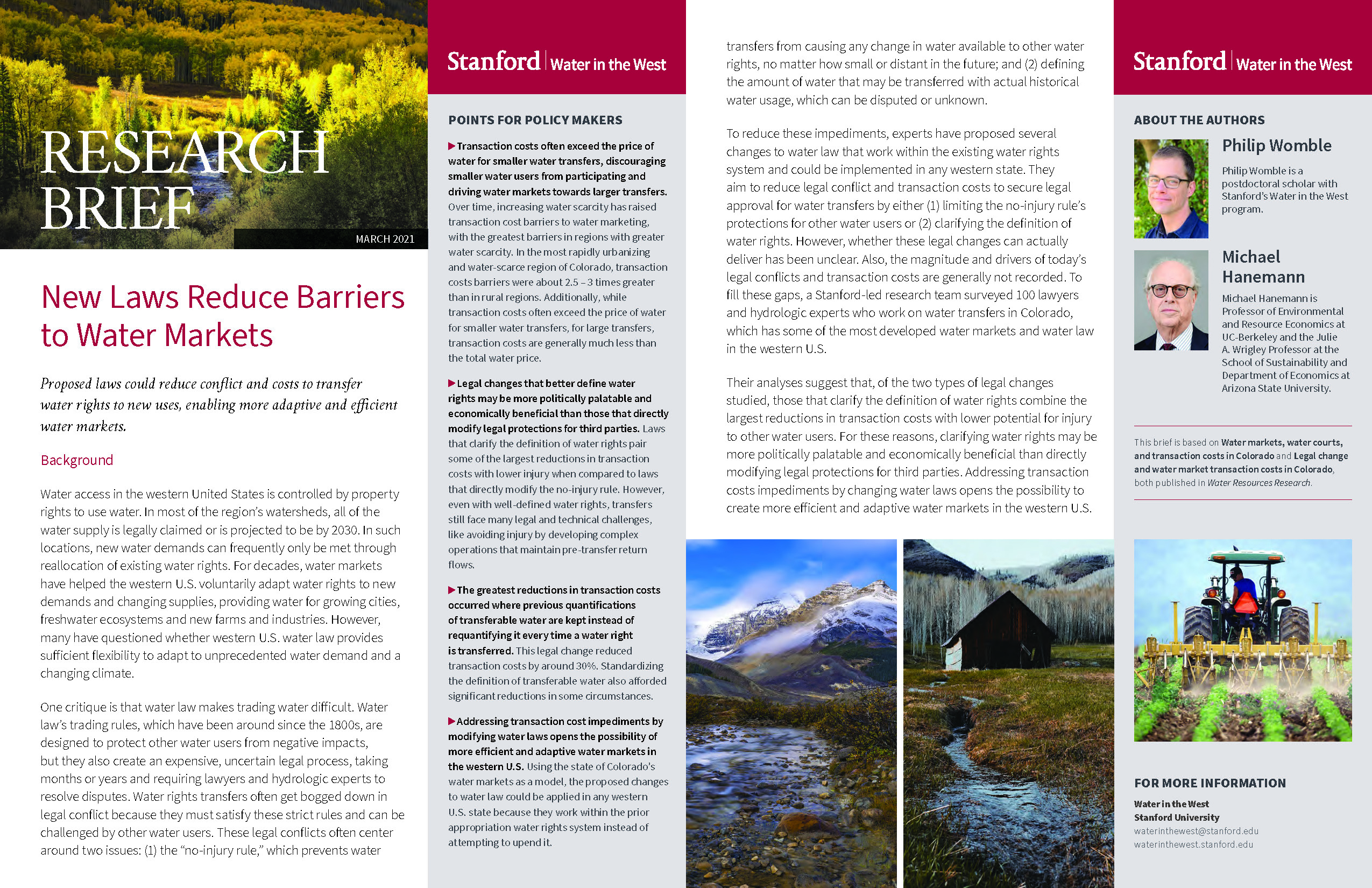March 08, 2021 | Water in the West | News
Much like real estate, water – or rather the right to use water – can be bought and sold in western states. Starting in the 19th century, water rights across the West were set on a first come, first served basis, where the first water user that diverted a river, stream or aquifer for certain uses held a right to use that water. It is estimated that by 2030, the entire water supply will be legally claimed in most western U.S. watersheds, with little to no water left for new users. At the same time, factors such as population growth, urbanization, industrial development and climate-induced drought have stressed water supplies across the western states.
Voluntary water markets – where existing water rights owners sell or lease their rights to new users – provide one solution to adapt water use. However, transferring the rights often entails a difficult, costly and slow process. Changes to western U.S. water law that address some of these impediments have been suggested, but whether they can help has remained unclear. In two recent studies Philip Womble, a postdoctoral scholar at Stanford’s Program on Water in the West, examined how some of these suggested changes could impact Colorado’s water rights system, exploring to what degree they alleviate barriers in the water transfer process.
Below, Womble discusses his work and findings.
How has water law impeded adaptation to water scarcity with water markets?
Any time a water right is transferred – like when expanding cities need new water supplies and buy water rights from nearby farms – a state agency or court must legally approve it. To secure this approval, the transfer must satisfy strict legal requirements, and other parties can legally object. Instead of creating a quick, smooth and predictable process, it often takes months or years and requires lawyers and hydrologic experts to resolve conflicts with other water users. The costs incurred to secure legal approval – what economists label a type of transaction cost – can be major impediments to adaptively and flexibly managing water supplies.
Have any changes to water law been proposed to address this problem?
Yes, many changes to water law have been proposed. Some critics have proposed completely scrapping existing water rights systems, while others have suggested legal changes that add flexibility to the existing system. In our study, we examined four separate changes to water law that work within the existing system. Although these potential legal changes could theoretically be implemented in any western U.S. state, we investigated them in Colorado, which has some of the most developed water law and water markets in the U.S.
What were the proposed changes you assessed?
The legal changes we studied aim to address two primary hurdles to water transfers. The first two relax the no-injury rule of western U.S. water law. Moving water use from one location to another on a river or aquifer or changing the type of water use can reduce water supplies available to other water rights. Legally, these reductions are called injury. The no-injury rule prohibits water transfers from causing any reduction in the timing, location and amount of water available to other water rights, no matter how small or distant in the future. As you can imagine, this rule often creates expensive and lengthy legal conflicts over small amounts of water.
The other two legal changes would more clearly define water rights, because the amount of water that can be acquired through a water transfer is frequently uncertain. One source of uncertainty in the definition of water rights is water law’s “use it or lose it” principle. This principle restricts the amount of water that can be transferred to the actual amount of water used in the years before a transfer – not the quantity of water listed on legal documents that have registered the water right. Because actual water usage many years ago is often disputed or unknown, this issue can also lead to expensive legal disputes.
How did you go about assessing the impacts of these legal changes?
We surveyed 100 water rights professionals, both lawyers and hydrologic experts, first collecting data on legal conflict and transaction costs for various water transfers under existing water law. We did this by presenting survey participants with hypothetical but realistic water transfers, and we asked them to evaluate the degree of legal conflict the transfer would encounter and then the costs to secure legal approval. Then, we provided a legal change and asked how legal conflict and costs would differ, if at all. Separately, to understand how the legal changes might negatively impact other water users, we asked participants to rank the legal changes from most to least likely to increase legal injury.
What were some of your key findings?
We found that, under existing water law, increased water scarcity drives greater legal barriers to water marketing. Regions with greater water scarcity have greater transaction costs, and these transaction costs have increased over time alongside growing water scarcity. As scarcity has grown, survey participants reported legal conflicts have become more protracted. For example, one water attorney told us that water transfers that might have resulted in two-page court decrees in previous decades commonly end up being 50 pages or more now.
We also learned that smaller water transfers face greater relative barriers than larger transfers because all tend to require some fixed amount of work. For smaller water transactions, the costs to secure legal approval often exceed the total price of water. Our analysis suggests that this has probably discouraged some smaller water transfers from occurring, meaning that smaller water users may be disproportionately excluded from water markets.
Finally, because the degree of legal conflict that a water transfer will encounter is uncertain, we found that transaction costs are also substantially uncertain before a water transfer begins, which can also discourage transfers.
Based on your findings, which legal changes are the most beneficial?
Legal changes that clarify the definition of water rights instead of directly modifying the no-injury rule provide some of the greatest reductions in legal barriers to water marketing and also less negative externalities for third-party water users. That suggests that legal changes that focus on clarifying water rights may be more politically palatable and economically beneficial than legal changes that directly modify legal protections for third-party water users.
Are these findings applicable in other parts of the western United States?
Colorado’s legal process for water rights transfers probably introduces unique frictions as it is the only western U.S. state where water courts perform the first review of water rights transfers instead of government agencies. However, because Colorado applies similar legal standards for water rights transfers as other western states, our general findings about drivers of transaction costs probably apply elsewhere in the West. In particular, because water scarcity is growing in many parts of the western U.S., it is plausible that other states will also experience increasing barriers to adapting water use in regions with greater scarcity.
Michael Hanemann, a professor of Environmental and Resource Economics at UC Berkeley and the Julie A. Wrigley Professor at the School of Sustainability and Department of Economics at Arizona State University, co-authored both Water Markets, Water Courts, and Transaction Costs in Colorado and Legal Change and Water Market Transaction Costs in Colorado.
For more information read the "New Laws Reduce Barriers to Water Markets" research brief.




![[Woods Logo]](/sites/default/files/logos/footer-logo-woods.png)
![[Bill Lane Center Logo]](/sites/default/files/logos/footer-logo-billlane.png)